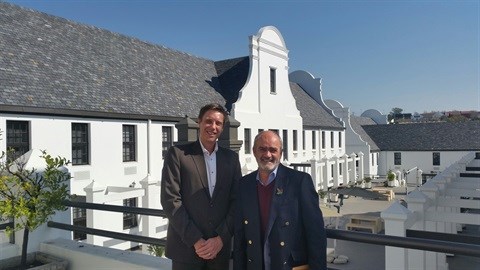The one hundredth building certification by the Green Building Council of South Africa (GBCSA) with a 5-Star Green Star SA Existing Building rating was officially awarded to Kirstenhof Office Park in Paulshof, Sandton.
Its elegant Cape Dutch design buildings are located on Witkoppen Road at the Rivonia N1 off-ramp. Kirstenhof Office Park's long list of green features include energy efficient lighting including fluorescents fitted with high frequency ballasts, flow restrictors on all taps, an operation waste and materials management plan and a storm water management plan to limit disruption of natural hydrology, minimise pollution and site deterioration.

Werner van Antwerpen, who heads up Growthpoint Properties’ specialised sustainability division, left, with Brian Wilkinson, CEO of the Green Building Council of South Africa (GBCSA), right, at the Kirstenhof Office Park in Johannesburg. Kirstenhof, owned by Growthpoint, has become the 100th building to achieve a Green Star SA certification from the GBCSA.
A Green Star SA rating guarantees that businesses live up to their green building claims. Independent assessors are employed to evaluate submissions and allocate points based on the green measures that have been implemented. Certification is awarded for 4-Star, 5-Star or 6-Star Green Star SA ratings.
Commitment to sustainability
"Achieving 100 certifications indicates the commercial property sector's commitment to sustainability and resource efficiency in response to growing cities and related challenges to energy infrastructure," Brian Wilkinson, CEO of the GBCSA, comments.
"There are multiple incentives involved in green building initiatives. Ultimately the upward trend in the number of buildings being certified and those applying for certification illustrates that awareness and perceptions around environmental issues have changed and evolved. Energy efficiency and the financial rewards notwithstanding, green building is the right thing to do," says Wilkinson.
Given the sustainable, green implementations in these building projects, their positive impacts are far reaching. The 100 Green Star certified projects achieve the combined annual savings of 131 million kilowatt hours of electricity - the equivalent of powering 9,130 households for a year. This takes massive pressure off South Africa's struggling power grid.
The 100 certifications also save a total of 176 million kilograms of carbon emissions - the same as taking 44,096 cars off the roads, or 5,000 full Boeing 747 flights travelling from Johannesburg to Cape Town. Plus, they save 171 million litres of drinking water, which equates to the daily water requirements for nearly 86 million people for one day.
Meaningful impact
All these savings also have a meaningful impact to the bottom lines of the businesses that own and occupy these green buildings. In addition to creating more sustainable and productive environments, the financial incentives of operating green buildings are also being realised, particularly in the face of South Africa's water scarcity and increasing energy costs.
Gauteng leads South Africa with the largest number of certified Green Star SA projects - an impressive 55. It is followed by the Western Cape with 29, KwaZulu-Natal with 11, the Eastern Cape with two and Limpopo with one. GBCSA has also certified two international ratings.








































